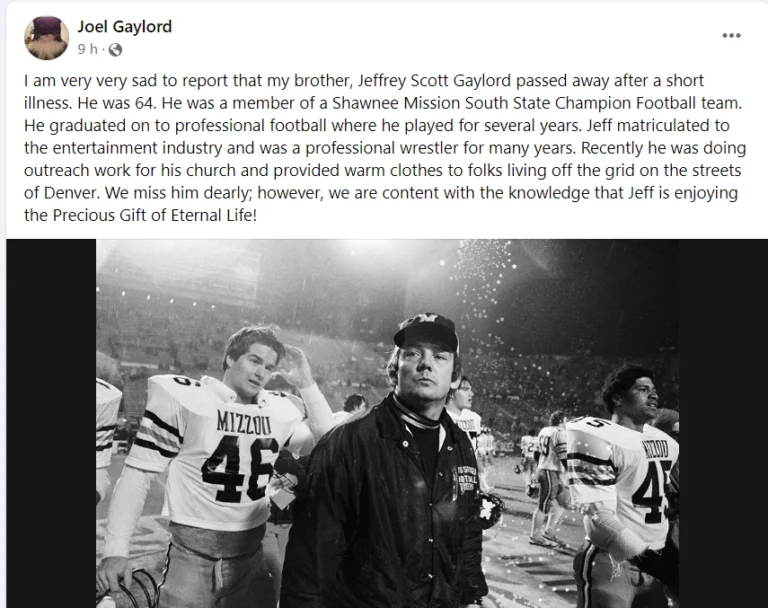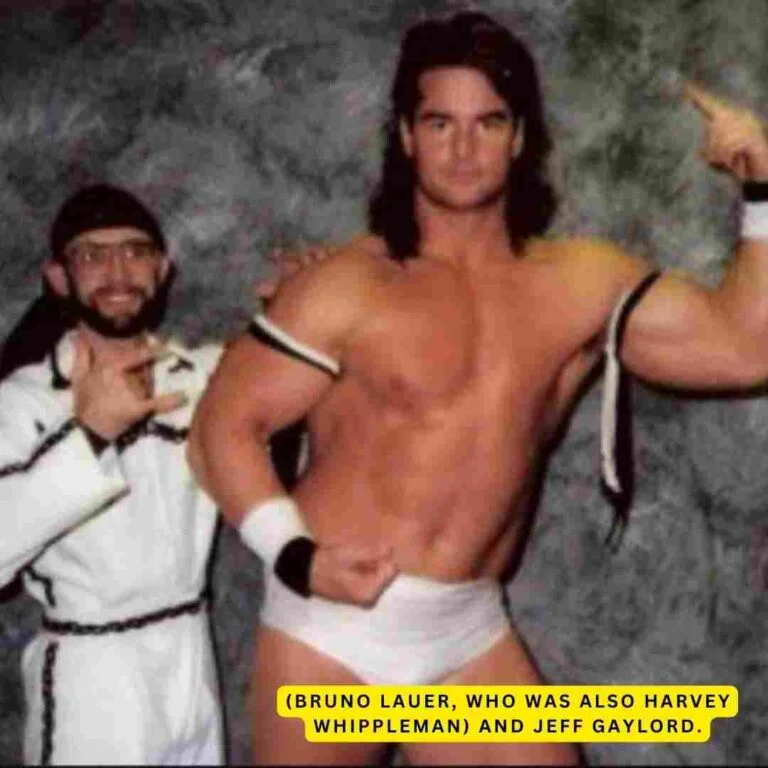Jeff Gaylord Cause of Death? How Did Professional Wrestler Die Explained
Former football player turned wrestler Jeff Gaylord passed away at the age of 64. Jeff Gaylord was a former defensive end in the CFL and USFL.
What Happened to Jeff Gaylord?
Jeff Gaylord, who worked for organizations like the GWF, the USWA, and WCCW, has died. His brother announced the passing news of Jeff Gaylord on his official Facebook page and the statement reads the following,
I am very very sad to report that my brother, Jeffrey Scott Gaylord passed away after a short illness. He was 64. He was a member of a Shawnee Mission South State Champion Football team. He graduated from professional football where he played for several years. Jeff matriculated in the entertainment industry and was a professional wrestler for many years. Recently he was doing outreach work for his church and provided warm clothes to folks living off the grid on the streets of Denver. We miss him dearly; however, we are content with the knowledge that Jeff is enjoying the Precious Gift of Eternal Life!

Jeff Gaylord Cause of Death
As a skilled heel wrestler, Jeff Gaylord deserves to be remembered among the Von Erichs’ primary rivals in Dallas during the waning days of WCCW and the early days of USWA. Gaylord was a member of the cast of villains that made late-’80s Texas wrestling so great, along with Al Perez, John Tatum, Billy Joe Travis, and Gary Young.
According to official reports, it was confirmed that Gaylord passed away after a short illness. There are not yet any details regarding Gaylord’s illness or demise. He is thought to have passed away on March 15, 2023.
In the fascinating book about the upstart league, Football For a Buck, Jeff Pearlman wrote about Gaylord:
Perhaps the best training camp narrative belonged to a pair of Boston Breakers. First, there was Jeff Gaylord, a nose tackle and former fourth-round draft pick of the Los Angeles Rams who, while attending the University of Missouri from 1978 to 1982:
Went on a five-month cocaine binge that, he recalled, “fried my brain.” Agreed to fill in for an absent male stripper at the nightclub where he worked as a bouncer. Gaylord purchases a tin of green paint coated his body head to toe, and nicknamed himself “the Incredible Hulk.” That night he was arrested for indecent exposure and fined $50. Filled his body with every imaginable steroid and steroid knockoff. Served as a certified chiropractor who arrived early to the stadium to crack his teammates’ backs before games.
Who was Jeff Gaylord?
In Des Moines, Iowa, on October 15, 1958, Jeff Gaylord was born. He developed into a 6-foot-3, 255-pound linebacker and defensive lineman. In 1975, his Overland Park, Kansas-based Shawnee Mission South high school squad won the state championship.
The Raiders defeated Wichita Southeast to win the Class 5-A football championship under head coach John Davis. Gaylord served as the team’s noseguard.
In 1977, Gaylord traveled to Missouri next. Gaylord had to redshirt his first year at Mizzou after breaking his sternum in a car accident. In many ways, he was an afterthought who gained notoriety in the 1981 campaign.
Associated Press All-America team
According to his story, he was unexpectedly selected to the Associated Press All-America team in December 1981. “Are you serious?
He said in the report that followed the announcement, “This is amazing. “Ever since I started playing organized football as a young child, this is something I’ve always envisioned for myself.
Everyone hopes their version of this will occur. The Associated Press had previously named him the Big Eight’s defensive player of the year. “When I was a freshman, I told myself that one day, along with all the other Missouri All-Americans from the past, my photo will be there [in the training room]. But after that, I kind of lost track of it,” Gaylord added.
The Los Angeles Rams of the NFL selected him 88th overall in the fourth round, but he was released during training camp. He participated in four games for the Toronto Argonauts of the CFL in the summer of 1982.
Football Career
Boston Breakers: United States Football League
Thereafter, he joined the Boston Breakers of the United States Football League, a group of oddballs that was characteristic of the league.
Gaylord spent 13 games with the Breakers before moving to New Orleans with the team and finishing his career with the San Antonio Gunslingers. He had 10.0 QB sacks in all during his USFL career. In every pro stop, he wore jersey number 61.
When the Breakers played in New Orleans, Pearlman spoke with Gaylord about it. “Drugs, drugs, drugs—accessible everywhere in New Orleans, and we had so many men who used,” he recalled. Most of us were underprivileged, and once the checks began to arrive, the cocaine followed. The black guys smoked it, while the white guys snorted it. We broke down.
Gaylord added further detail in a different area. Drug use was widespread in the USFL, according to Gaylord. “I once went to my coke dealer, bought a bag for $1,000, tooted it, and played all night. That’s how sports were in the 1980s.
With his football career terminated due to a serious knee injury, Gaylord, who had participated in bodybuilding competitions, went to pro wrestling.
Professional wrestling debut
In October 1985, Gaylord made his professional wrestling debut in San Antonio, where his football career came to an end. In a San Antonio gym, he met Scott Casey and Tom Jones. Gaylord claimed, “They trained me in a tin shanty in 100-degree weather… Both a breeze and water were absent. They taught me all I needed to know in four months.
When Gaylord was competing for Bob Geigel’s All-Star Wrestling in February 1986, The Kansas City Times caught up with him and reported the early stages of his wrestling mayhem. The shrieks are flattering, Gaylord told columnist Jonathan Rand. I’m attempting to be the attractive, modest guy.
No one my size is as cut up (well-defined) and well-proportioned in any sport, Gaylord continued, “and I have been informed that in six months I may be Mr. Olympia material. I don’t want to sound boastful, but I have been gifted with a unique figure.
That is a large, attractive youngster, isn’t he? Geigel told the Times that he saw potential in the young man. Pro wrestling was in upheaval at the time because the territories were closing. Although most of his matches were at best middle of the bill, Gaylord worked in the early days for Bill Watts’ Universal Wrestling Federation.
“Missouri Tiger”
The Dallas-based World Class Championship Wrestling gave “Missouri Tiger” Gaylord more exposure. He began by assuming the identity of The Hood. When World Class and the USWA of Memphis merged, he was a contender and shared two USWA tag team championships with Jeff Jarrett. By 1995, he had left the USWA and was performing everywhere he could, notably for the American Wrestling Federation, which only lasted briefly.
He participated in a few WWF tryouts and one WCW appearance. He was also one of Shawn Michaels’ masked Knights. “Gaylord had a nasty reputation in wrestling, and once assaulted and beat up Eddie Gilbert in a dressing room when both worked for the Global Wrestling Federation, supposedly as a hit from a promoter,” wrote Dave Meltzer of the Wrestling Observer Newsletter in 2009.
Gordon Scozzari, who advertised certain TV tapings for which Gilbert was to be the booker but failed to show up, has consistently denied setting Gaylord up. He also had a poor reputation in the locker rooms.

Jeff Gaylord’s Detention
After wrestling, life was challenging. $5,000 was stolen during a bank robbery in Aurora, Colorado, in 2001. Four months later, the same bank was targeted and the robber was apprehended. After entering a guilty plea, he was imprisoned for six and a half years.
He was charged with this and another attempted bank robbery of a U.S. Bank branch in Castle Rock, Colorado, after being apprehended in Monument, Colorado, in January 2009. He attributed the robberies to “personal economic difficulties”.
